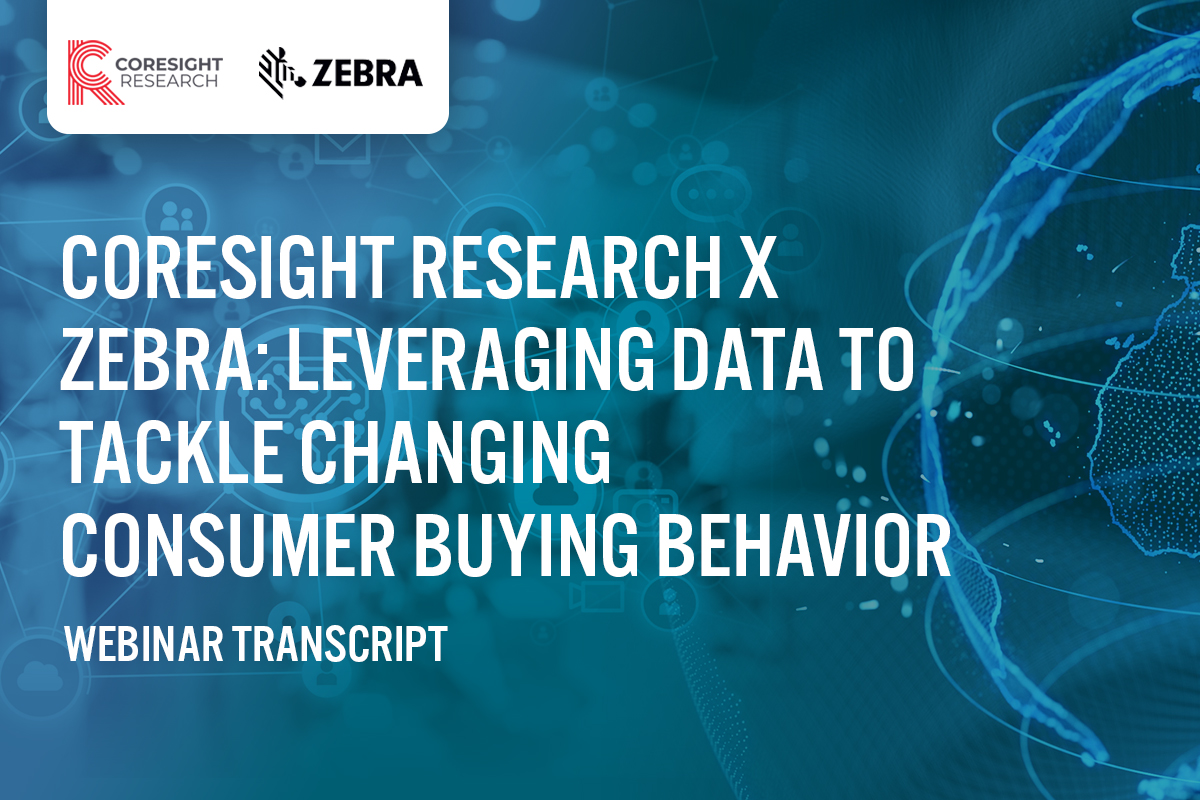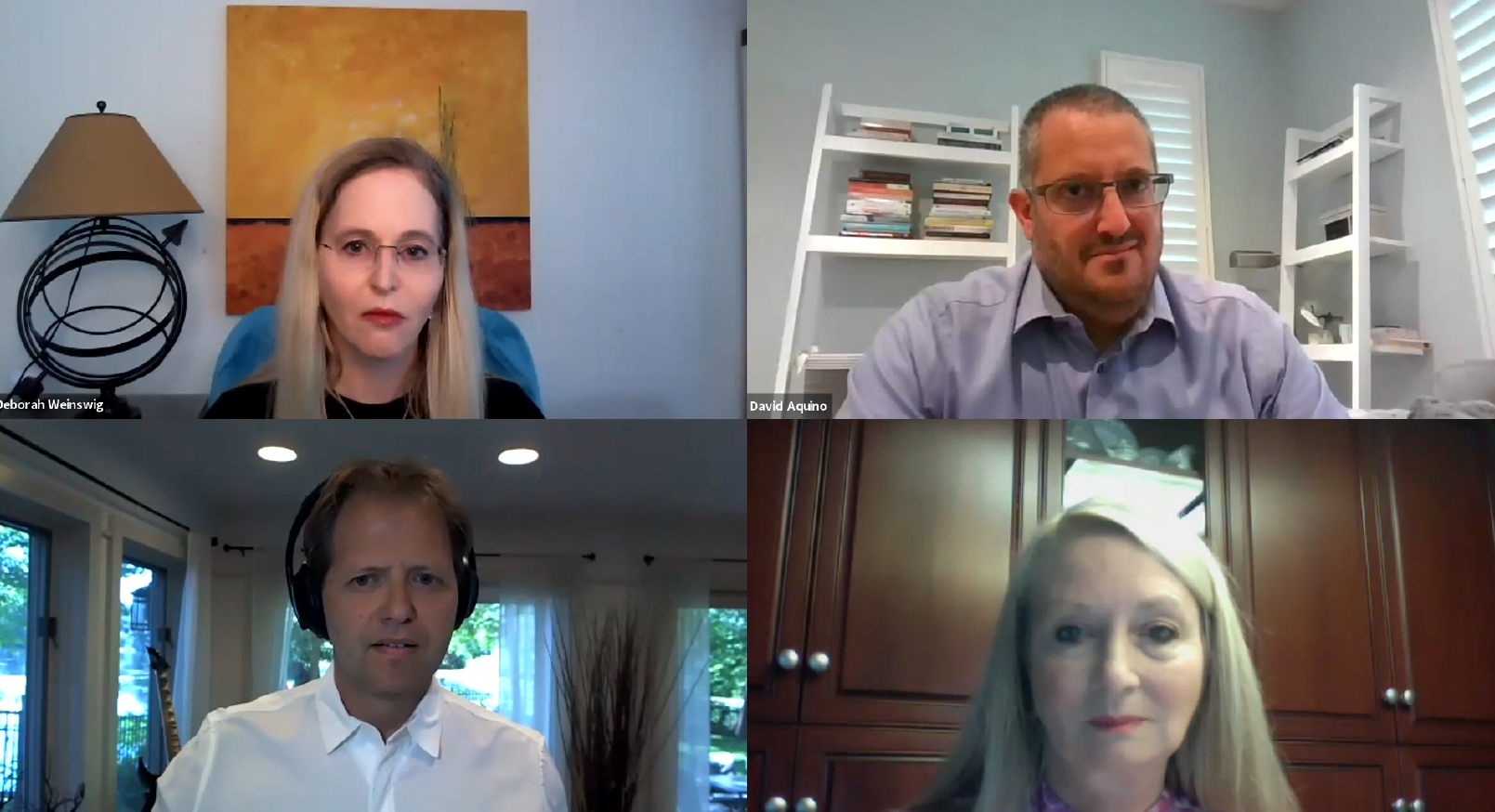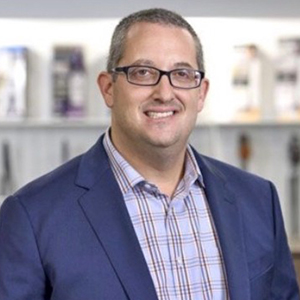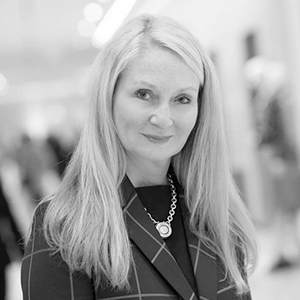
DIpil Das
We present an edited version of our conversation with Andrea Weiss, Founding Partner of The O Alliance, and David Acquino, former COO of SharkNinja, from a webinar held on June 18, 2020 by Coresight Research and Zebra. The webinar was hosted by Deborah Weinswig, CEO and Founder of Coresight Research, and Guy Yehiav, General Manager of Zebra Analytics. We profile the speakers and their companies at the end of this report.
 Deborah Weinswig (top left); David Aquino (top right); Guy Yehiav (bottom left); Andrea Weiss (bottom right)
Deborah Weinswig (top left); David Aquino (top right); Guy Yehiav (bottom left); Andrea Weiss (bottom right)
Source: Coresight Research [/caption] Deborah Weinswig: We typically see about an 8% out of stock rate. We are hearing from an industry perspective that it is heading closer to 12%. We are starting to hear a few things from executives:
 David Aquino was most recently COO of SharkNinja, a US designer, marketer and distributor of home devices and appliances—and was CIO of the company prior to that. He has over 20 years of experience with brands such as Aramark, Barco Uniforms, Pepsi and Unilever, with expertise across team building, supply chain, technology and operations.
David Aquino was most recently COO of SharkNinja, a US designer, marketer and distributor of home devices and appliances—and was CIO of the company prior to that. He has over 20 years of experience with brands such as Aramark, Barco Uniforms, Pepsi and Unilever, with expertise across team building, supply chain, technology and operations.
 Guy Yehiav is General Manager of Zebra Analytics. He is responsible for setting the organic and non-organic growth, leadership strategy and customer success for the Zebra Analytics business unit. Formerly CEO of Profitect, recently acquired by Zebra Technologies, and a 25-year veteran of the supply chain industry, Yehiav has held senior leadership positions at Oracle and was previously founder of Demantra US (acquired by Oracle in 2006). He is a guest lecturer on professional selling, entrepreneurship and statistics for the Massachusetts Institute of Technology (MIT) and Babson College.
Overview: Zebra Technologies
Zebra empowers those on the front line in retail, health care, transportation and logistics, manufacturing and other industries to achieve a performance edge—which translates to customer satisfaction, good patient outcomes and improved business results.
Zebra’s products, software, services, analytics and solutions are used to intelligently connect people, assets and data. With decades of industry experience, the company designs with front-line users and workplaces in mind, providing the best-action guidance needed to optimize in-motion operations and make business-critical decisions. Zebra has over 10,000 partners across 100 countries.
Guy Yehiav is General Manager of Zebra Analytics. He is responsible for setting the organic and non-organic growth, leadership strategy and customer success for the Zebra Analytics business unit. Formerly CEO of Profitect, recently acquired by Zebra Technologies, and a 25-year veteran of the supply chain industry, Yehiav has held senior leadership positions at Oracle and was previously founder of Demantra US (acquired by Oracle in 2006). He is a guest lecturer on professional selling, entrepreneurship and statistics for the Massachusetts Institute of Technology (MIT) and Babson College.
Overview: Zebra Technologies
Zebra empowers those on the front line in retail, health care, transportation and logistics, manufacturing and other industries to achieve a performance edge—which translates to customer satisfaction, good patient outcomes and improved business results.
Zebra’s products, software, services, analytics and solutions are used to intelligently connect people, assets and data. With decades of industry experience, the company designs with front-line users and workplaces in mind, providing the best-action guidance needed to optimize in-motion operations and make business-critical decisions. Zebra has over 10,000 partners across 100 countries.
 Andrea Weiss, a Founding Partner of The O Alliance, has 30 years of retail expertise and was an early innovator in multichannel commerce. Weiss has extensive expertise in developing high-level business strategy and tactical execution plans for leading retailers and brands.
She has been a board member at GSI Commerce and has served as Chief Stores Officer at L Brands. Recently, she has been behind the scenes of Chico’s, Pep Boys, Cracker Barrel and Nutrisystem, where she currently serves on the Boards of Directors. Weiss presently serves as CEO of Retail Consulting, Inc., a boutique-consulting firm focused on the retail and consumer industry in both Europe and the US.
Overview: The O Alliance
The O Alliance is a new consulting model that leverages a network of transformational practitioners with deep expertise in all of the critical disciplines required to unlock value in retail and digital commerce. Using its exclusive "The O Method", the company helps guide organizations to a new paradigm: “Seamless Circular Commerce.”
Andrea Weiss, a Founding Partner of The O Alliance, has 30 years of retail expertise and was an early innovator in multichannel commerce. Weiss has extensive expertise in developing high-level business strategy and tactical execution plans for leading retailers and brands.
She has been a board member at GSI Commerce and has served as Chief Stores Officer at L Brands. Recently, she has been behind the scenes of Chico’s, Pep Boys, Cracker Barrel and Nutrisystem, where she currently serves on the Boards of Directors. Weiss presently serves as CEO of Retail Consulting, Inc., a boutique-consulting firm focused on the retail and consumer industry in both Europe and the US.
Overview: The O Alliance
The O Alliance is a new consulting model that leverages a network of transformational practitioners with deep expertise in all of the critical disciplines required to unlock value in retail and digital commerce. Using its exclusive "The O Method", the company helps guide organizations to a new paradigm: “Seamless Circular Commerce.”
Changing Consumer Behavior: Impacts for Inventory Management
Guy Yehiav: Over the past few months, we have seen new trends around when and how consumers shop—specifically, we see that store traffic is down, but conversion is up. What do you think is driving this change? Andrea Weiss: First and foremost, I think it is important to recognize that the changes we are going to discuss today are global changes. My clients range from Canada to Europe—including hard-hit countries like Spain and Italy—and of course here in the US. So, the change that is underway is wide-reaching and has many permanent aspects to it.- Essential retailers had the benefit of having their doors open, but they are seeing fundamental shifts in how consumers are shopping and what their expectations are. They are benefiting from things that they had perhaps in the works but have now fast-tracked in order to be able to provide better online curbside pickup and those kinds of models.
- For the stores that are in the reopening phases, it is not an equal and democratic return. Fashion is having a much more sluggish return, but other industries are exceeding their plans—one of my clients, for instance, had developed quite a strict plan for their recovery period in order to have proper resources allocated and are now beating those projections by 250 basis points.
- Consumers are definitely returning, but they are returning in a different way. I think you are seeing much more purposeful shopping, and that purposeful shopping is actually something that is going to stick with us.
 Deborah Weinswig (top left); David Aquino (top right); Guy Yehiav (bottom left); Andrea Weiss (bottom right)
Deborah Weinswig (top left); David Aquino (top right); Guy Yehiav (bottom left); Andrea Weiss (bottom right) Source: Coresight Research [/caption] Deborah Weinswig: We typically see about an 8% out of stock rate. We are hearing from an industry perspective that it is heading closer to 12%. We are starting to hear a few things from executives:
- Assortment optimization. So, still being in those categories but having fewer suppliers and fewer vendors, so that they can guarantee products on the shelf.
- Retailers that had never thought about RFID are now thinking that they need to be able to understand that items are in the store somewhere—hopefully on the shelf—when fulfilling from stores.
- Improving demand forecasting.
Business Intelligence and Supply Chain
Guy Yehiav: Are business intelligence (BI) models sufficient to adapt to this new trend? Deborah Weinswig: I think BI models are more important than ever—we have heard more and more discussions around this idea of anomalies and data. I feel that there is this idea of finding solutions to a challenge very quickly. There is pressure to have a really quick turnaround when you have everybody's attention and there are funds available to do it. I think that getting everyone on board is much easier in this environment, from a C suite perspective. For holiday 2020, we are already seeing a lot of new technologies being investigated and a lot of new technology providers. People really want to make decisions on which technology to use the next few weeks, because they want to have these ready for the holiday. Andrea Weiss: I am seeing that in real time. You have projects that were in discovery that have gone into implementation, in some cases, in less than three or four weeks—technologies that are very agile can be implemented quickly. Consumer needs are being prioritized, as well as the ability for new technology to interface quickly with existing platforms. David Aquino: There are so many new supply chain designs out there. If you look at the constipation of the supply chain today in terms of getting products out of China and the pricing for air freight and for management of products, you can see that this idea of scarcity creates weird dynamics for the shopper.I would argue that whether we talk about BI or about supply chain flexibility, CPG retail partners need to be able to quickly adapt to new sources of supply, new countries of origin, new logistics, new packaging and reuse. Shopping habits and behavior, both on shelf and experiential, require things to be deployed quickly but ultimately do not require too much filtering. With the amount of social media and insight that is out there, it does not take a brain surgeon to figure out that consumers are furious, and if they had another option, they would take it. The retailers that are successful are going to be those that are able to get great messaging to consumers about store safety and inventory management. I think that BI, like all technology, is not a surrogate for being on the ground. Guy Yehiav: How would you recommend sensing demand and actually acting on that data rather than continuing with supply chain conservation? David Aquino: The volatility of outlier demand should not be taken at face value, because we know the marketplace is all over the place. My argument is that it is still important to have a direct relationship with the customer and then marry that at the store operations level as to what needs to be adjusted. Deborah Weinswig: We have heard from many of the luxury retailers who do not have e-commerce that what they have started to do in this environment—and it has actually been unbelievably successful—is virtual selling. It ends up bringing about a different type of relationship and different type of entertainment to shopping experiences. That is great for the sales associate; it is great for the retailer; and it is great for the consumer. David Aquino: I have been working with some clients with very personal sales spaces that had historically required customers to go into a store or salon to be helped. When you have no salons open and no physical opportunities, the almost accidental epiphany is that this could still be a really personal and individual experience. If we can do digital proposals and digital insight and provide product education, the conversion is incredible. The questions will be how to scale it properly and how to educate associates to be able to manage this type of relationship.“It does not take a brain surgeon to figure out that if consumers had another option, they would take it.” -David Aquino
Labor in the Retail Sector
Guy Yehiav: Unemployment has been on the rise right because of Covid-19. What will happen with labor in the short, medium and long term? Andrea Weiss: We do need to think about this in relation to those exact brackets:- Short term—Employees were laid off en masse, and we are now seeing a slow rollout of bringing people back. We have seen people deployed into functions that they have never done before and companies having to accelerate training and staffing to compensate for reduced hours and reduced traffic. It is about survival.
- Medium term—I think that you will begin to see an appetite for how to build those changes into a business model. I am not certain that we will see returns for all job functions, and I think you will see a re-education, retraining and repurposing of some employees, but I'm concerned about some folks’ jobs being permanently lost.
- Long term—I am anticipating CEOs to be interested in BI, because their fundamental business model is going to change. They are going to need to make investments to figure out how to be very agile, redeploy labor and work with fewer people simply because of safety issues. I see a redevelopment of the workforce that is going to be very much tied into the ability to deploy with speed, where BI is going to become vital.
Andrea Weiss: Too often optimizing labor means simply cutting costs, but we have a responsibility to retool our workforce, and these technologies can really help us in that regard.“We have a responsibility to retool our workforce” – Andrea Weiss
Data and Technology: Personalization and Priorities
Guy Yehiav: How do you see technology and data benefiting brands and retailers? Deborah Weinswig: Data does not lie, right? It tells us the truth at a point in time and can also be predictive. I think that we are seeing investments right now in this area—we will see mistakes along the way, but I think that is okay. I think ultimately your shareholders will reward you. David Aquino: I think that the challenges are the quality of the data, the ability to digest it, the ability to reduce time lags and then having real ownership and independence to interpret what the data means. I think it is critically important, because we are challenging a lot of orthodoxy around how retailers have operated and how consumers behave. The reality is that it is a little bit of trial and error. I am not sure the consumer even knows what they want right now. We have this amazing diversity, and the smart organizations are not going to be terrified by it—they are going to be excited by it. The ones that are frightened by the future are not going to survive. Deborah Weinswig: This relates to the idea of personalization. There is a lot of data, especially if you are a warehouse club and have data on every transaction. To have the feeling that the retailer knows you and gives you permission to serve up what the consumer is most likely to purchase can save a lot of time in terms of sorting through products. We all want something different, and it is the retailer that can deliver it to us. Then it really becomes our retailer.Andrea Weiss: I think of this as a moment in time where we could actually think about technology as allowing us to return to the basics of what retail is—that consumer relationship. We could use this as a reset as a way to get back to the most basic things—such as stock, availability and customer relationship services. This is a time where we are all listening better. If data and the use of data can allow us to get back to the basics of our industry, we will have a strong industry coming out of this. Guy Yehiav: Throughout reopening and post Covid-19, what will be the priority for the top retailers in terms of technology? Andrea Weiss: I think first and foremost most retailers are collapsing channels—and so technologies that allow that. I think real insights on consumer behavior have been talked about for a long time. Also, inventory integrity because of the real challenges that the supply chain has faced. David Aquino: I think having real insights on the consumer experience and on the availability of staff and interactions. There is so much listening required and understanding of when the consumers are coming to stores and what they want. Anything that can allow that truth to be told, and without latency and without too much filtering or manipulation. I think it will be really important because we are going to move pretty quickly from this scarcity and purpose-built shopping to finding a way to provide a great experience. I think this is the opportunity to really listen and learn. Deborah Weinswig: There is something different every week.“This is a time where we are all listening better. If data and the use of data can allow us to get back to the basics of our industry, we will have a strong industry coming out of this.” – Andrea Weiss
- This week it is about reducing returns. So, anything around mobile body scanning, virtual showrooms, or even 3D design.
- The week before that was about demand forecasting.
- The week before that, it was assortment optimization. There has been a lot of interest around RFID and on-shelf availability.
- I think that next week will be micro-fulfillment, especially as it relates to grocery, but we are now hearing that more from the fashion retailers too.
I think that there is a lot more intelligence being put into things. We are seeing sustainability for profitability’s sake underlying everything right now. I think when we started off 2020, it was sustainability just for sustainability’s sake. Consumers feel that retailers are listening to them, because sustainability is one of the most important aspects of their shopping journey right now. I have to applaud retail, because every single week there is new topic, and the fact that they have been able to adapt is nothing short of amazing.I have to applaud retail because the fact that they have been able to adapt is nothing short of amazing. – Deborah Weinswig
 David Aquino was most recently COO of SharkNinja, a US designer, marketer and distributor of home devices and appliances—and was CIO of the company prior to that. He has over 20 years of experience with brands such as Aramark, Barco Uniforms, Pepsi and Unilever, with expertise across team building, supply chain, technology and operations.
David Aquino was most recently COO of SharkNinja, a US designer, marketer and distributor of home devices and appliances—and was CIO of the company prior to that. He has over 20 years of experience with brands such as Aramark, Barco Uniforms, Pepsi and Unilever, with expertise across team building, supply chain, technology and operations.
 Guy Yehiav is General Manager of Zebra Analytics. He is responsible for setting the organic and non-organic growth, leadership strategy and customer success for the Zebra Analytics business unit. Formerly CEO of Profitect, recently acquired by Zebra Technologies, and a 25-year veteran of the supply chain industry, Yehiav has held senior leadership positions at Oracle and was previously founder of Demantra US (acquired by Oracle in 2006). He is a guest lecturer on professional selling, entrepreneurship and statistics for the Massachusetts Institute of Technology (MIT) and Babson College.
Overview: Zebra Technologies
Zebra empowers those on the front line in retail, health care, transportation and logistics, manufacturing and other industries to achieve a performance edge—which translates to customer satisfaction, good patient outcomes and improved business results.
Zebra’s products, software, services, analytics and solutions are used to intelligently connect people, assets and data. With decades of industry experience, the company designs with front-line users and workplaces in mind, providing the best-action guidance needed to optimize in-motion operations and make business-critical decisions. Zebra has over 10,000 partners across 100 countries.
Guy Yehiav is General Manager of Zebra Analytics. He is responsible for setting the organic and non-organic growth, leadership strategy and customer success for the Zebra Analytics business unit. Formerly CEO of Profitect, recently acquired by Zebra Technologies, and a 25-year veteran of the supply chain industry, Yehiav has held senior leadership positions at Oracle and was previously founder of Demantra US (acquired by Oracle in 2006). He is a guest lecturer on professional selling, entrepreneurship and statistics for the Massachusetts Institute of Technology (MIT) and Babson College.
Overview: Zebra Technologies
Zebra empowers those on the front line in retail, health care, transportation and logistics, manufacturing and other industries to achieve a performance edge—which translates to customer satisfaction, good patient outcomes and improved business results.
Zebra’s products, software, services, analytics and solutions are used to intelligently connect people, assets and data. With decades of industry experience, the company designs with front-line users and workplaces in mind, providing the best-action guidance needed to optimize in-motion operations and make business-critical decisions. Zebra has over 10,000 partners across 100 countries.
 Andrea Weiss, a Founding Partner of The O Alliance, has 30 years of retail expertise and was an early innovator in multichannel commerce. Weiss has extensive expertise in developing high-level business strategy and tactical execution plans for leading retailers and brands.
She has been a board member at GSI Commerce and has served as Chief Stores Officer at L Brands. Recently, she has been behind the scenes of Chico’s, Pep Boys, Cracker Barrel and Nutrisystem, where she currently serves on the Boards of Directors. Weiss presently serves as CEO of Retail Consulting, Inc., a boutique-consulting firm focused on the retail and consumer industry in both Europe and the US.
Overview: The O Alliance
The O Alliance is a new consulting model that leverages a network of transformational practitioners with deep expertise in all of the critical disciplines required to unlock value in retail and digital commerce. Using its exclusive "The O Method", the company helps guide organizations to a new paradigm: “Seamless Circular Commerce.”
Andrea Weiss, a Founding Partner of The O Alliance, has 30 years of retail expertise and was an early innovator in multichannel commerce. Weiss has extensive expertise in developing high-level business strategy and tactical execution plans for leading retailers and brands.
She has been a board member at GSI Commerce and has served as Chief Stores Officer at L Brands. Recently, she has been behind the scenes of Chico’s, Pep Boys, Cracker Barrel and Nutrisystem, where she currently serves on the Boards of Directors. Weiss presently serves as CEO of Retail Consulting, Inc., a boutique-consulting firm focused on the retail and consumer industry in both Europe and the US.
Overview: The O Alliance
The O Alliance is a new consulting model that leverages a network of transformational practitioners with deep expertise in all of the critical disciplines required to unlock value in retail and digital commerce. Using its exclusive "The O Method", the company helps guide organizations to a new paradigm: “Seamless Circular Commerce.”